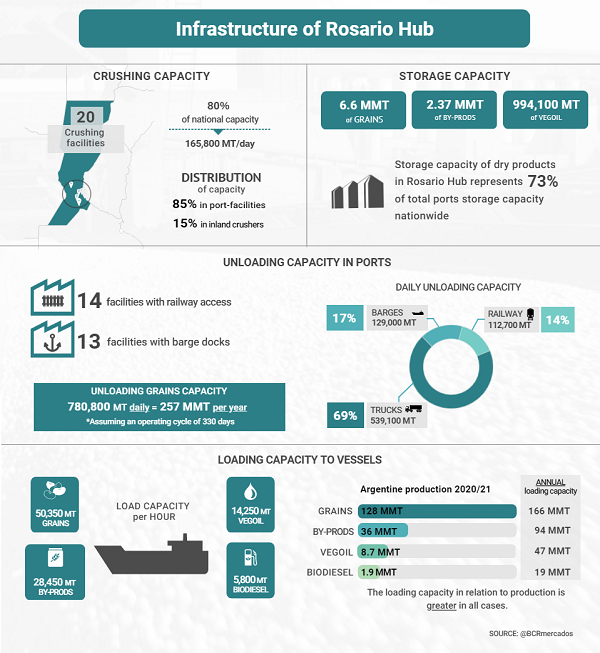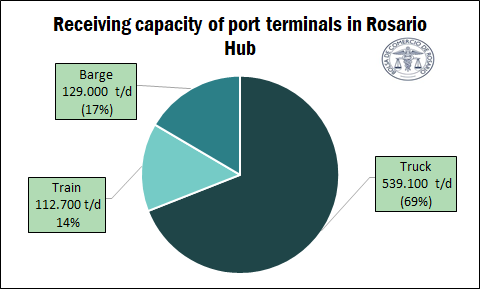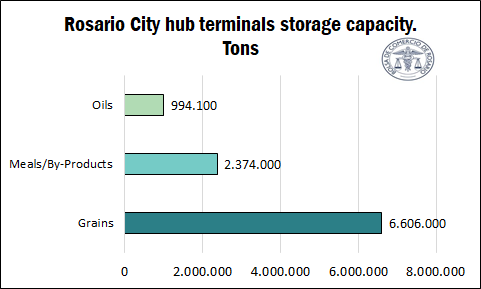Rosario city region stands out as the most important industrial-export hub of cereals and products of oilseed complexes in our country, and one of the most important in the world. In year 2020, only from the ports in the area, a gross total of 70 million tons (Mt) of grains, meals and oils were exported. During that year, from the port terminals located on the Up-River Paraná ports, there were shipped 70% of the grain, 96% of the vegetable oils, and 96% of meals exported by the country, for an approximate value of US$ 20,000 million, which equals 37% of Argentina's yearly exports.
Historically, Rosario has been the epicentre of bulk carrier port locations as a consequence of its privileged geographical position. On the one side, due to the closeness to one of the most productive regions of the world for cereal and oilseed cultivation, and on the other side, to the topographic benefits presented by the cliffy banks of the Paraná River on these latitudes for bulk loading of ships. In addition to these natural characteristics, a series of investments in dredging, logistics, human resources and productive infrastructure made since the decade of 1990 finished potentiating Rosario hub of ports as a world-class industrial-export cluster for agribusiness products and by-products.
From the Department of Information and Economic Studies of the Rosario Board of Trade, we conducted a survey of the companies that operate in this area. Next, we will give an account of the added capacities of the port terminals and factories of the area for receiving grains, storing and processing them, and shipping the products of the agribusiness complexes.
I) CAPACITY OF RECEIPT OF GOODS BY TRUCK, RAILWAY AND BARGE
FACT: The port terminals in Rosario hub have a daily receiving capacity of 539,100 tons of goods by truck, 129,000 t by barge and 112,700 t by railway.
The great influx of grains that arrive in Rosario hub from the national production areas generate in the members of the agricultural chain the need to count on a well-oiled logistic system that guarantees the order in the activities and provides solutions to the needs of both parts: the need of the producer to ship to port or plant as needed, and the need of buyers to receive those goods in a timely and proper manner.
The port terminals and plants in Rosario hub have three main routes to receive the grains that are going to be industrialized and/or shipped to our export destinations: facilities for truck receipt and unloading, rail accesses for receiving freight wagons, and barge quays for receiving goods by waterway. In a good harvest year, over 70 million tons of grains and by-products can arrive in Rosario through different means of transport. According to 2020 data, approximately 86.5% of the goods arrived by truck, 12.5% through the railway system and 1% via barges.
Currently, terminals have the capacity to receive about 18,970 daily trucks, which represents an approximate total of 570 thousand tons per day that can enter through the most used way by the grain trade sector in our country.
Also, 14 terminals have rail access in order to receive goods via that means. In total, it is estimated that 112,000 daily tons could be received by rail, assuming facilities operate at their maximum capacity.
Last, several of the ports of Rosario hub have the infrastructure to receive barges with goods, that frequently come from Bolivia, Paraguay and Brazil, as well as from Argentinian ports located on the Paraná and Paraguay rivers. Currently, 13 port terminals have barge quays with a theoretical capacity of barge convoy receipt and unload for a total of 129,000 tons per day.
Therefore, in total, Rosario hub port terminals can receive, through the various means of transport already mentioned, a total of 780,000 daily tons of goods or, assuming an operative cycle of 330 days a year, 257 million tons of products.
II) GRAINS, OILS AND BY-PRODUCTS STORAGE CAPACITY
FACT: Rosario hub terminals concentrate 73% of the solid storage capacity of all the grain ports in the country
The port terminals in Rosario hub have –as a total– a grain storage capacity (either in silos or stationary structures) of 6,606,000 tons, approximately. The storage capacity of by-products (meals and pellets) reaches 2,374,000 tons, and vegetable oils, 994,000 tons.
According to the Argentinian Ministry of Agriculture, Livestock and Fisheries, the total solid storage capacity in Rosario hub accounts for 73% of the total storage capacity of the country’s cereal ports (12,060,670 tons).
III) PROCESSING CAPACITY OF OILSEEDS IN PLANTS AND PORT-PLANTS
FACT: In Rosario hub there are 20 oilseed processing factories, which have an installed capacity of 165,000 tons per day. This represents 80% of the crushing capacity of the country.
In Rosario hub area of influence there are 20 soybean and sunflower processing factories, 12 of which have port facilities. It is necessary to clarify that we included in this calculation the factories in nearby areas, such as Chabás and San Jerónimo Sud, which although are not in the cluster, can be considered within its area of influence.
According to our survey and taking into account other reports, such as the one provided by Corredora-Broker J.J. Hinrichsen S.A., in Argentina the total theoretical oilseed processing capacity is approximately 204,000 tons per day, of which 80% is in the area of influence of Rosario hub, where there are plants capable of industrializing 165,800 tons per day. This results in a yearly processing capacity of approximately 54.7 Mt in the total area.
The productive scale varies widely between factories of the area, with the one with the lowest capacity processing 300 tons of oilseed per day at most ¡, and the largest factory boasting a crushing capacity close to 33,000 tons per day.
85% of the crushing and industrialization capacity of this area is in plants with a port over the Paraná river, and only 15% is in exclusively processing plants, which accounts for the strongly exporter profile of this industrial activity.
IV) VESSEL LOAD CAPACITY
FACT: Rosario hub terminals have facilities capable of loading 50,350 tons of grains per hour, 28,450 tons of by-products, 14,250 tons of oil and 5,800 tons of biodiesel.
According to our survey, it is estimated that Rosario hub terminals have facilities capable of loading 50,350 tons of grains per hour, 28,450 tons of by-products, 14,250 tons of oil and 5,800 tons of biodiesel.
Assuming a 10-hour per day work regime in these terminals, in an operative cycle of 330 days a year, we can estimate that from the ports of the region 166 Mt of grains, 94 Mt of by-products, 47 Mt of oil and 19 Mt of biodiesel could be shipped.
Two important aspects to bear in mind at the time of analysing the characteristics of the port terminals are the maximum length allowed and draft, which will define what kind of vessels can enter the area and how much cargo they can hold. In the port belt of Rosario hub, the minimum maximum length allowed is 230 meters, while the highest maximum length allowed is 297 meters. As for the usual draft of the terminals, the deepest one has 14.6 Mt (48 feet).
If we take into account production data for crop season 2020/21, we can estimate that from the terminals of Rosario hub it could be shipped 1.3 times the national grain production, 2.6 times the production of by-products, 5.4 times the production of oils, and 10 times the production of biodiesel.
In subsequent reports there will be briefings with a deeper analysis of each of the aspects mentioned in this article.



